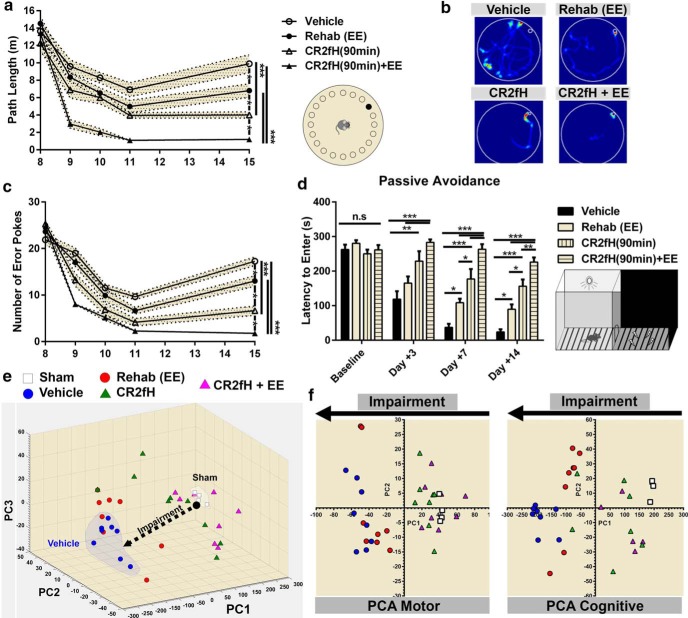Figure 4.
Improvement in cognitive performance after MCAO with rehabilitation, CR2fH, and combination therapy. a–c, CR2fH treatment alone or in combination with rehabilitation significantly improved spatial learning (days 9–11 after MCAO) and retention of learned memory (day 15 after MCAO) compared with vehicle controls, as assessed by the total path length before reaching the target hole (a) or the number of error pokes (c). Cotreatment with CR2fH and rehabilitation also reduced path length and number of errors significantly compared with rehabilitation alone during learning. At the retention phase, rehabilitation alone showed significant improvement in both measures compared with vehicle, whereas CR2fH + rehabilitation was significantly better than CR2fH alone. Statistical results of retention day are displayed. Two-way ANOVA, Bonferroni's correction, n = 8/group, *p < 0.05, ***p < 0.001. Results of multiple comparisons: (1) day 8: no significant difference between groups; (2) day 9: vehicle versus CR2fH: p < 0.05, vehicle versus CR2fH + rehabilitation: p < 0.001, rehabilitation or CR2fH versus CR2fH + rehabilitation: p < 0.01; (3) day 10: vehicle versus CR2fH: p < 0.001, all groups compared with CR2fH + rehabilitation: p < 0.001; (4) day 11: vehicle versus CR2fH: p < 0.05, all groups compared with CR2fH + rehabilitation: p < 0.001; and (5) day 15: displayed on graph. d, Passive avoidance task revealed that animals treated with CR2fH with or without rehabilitation have better memory retention (longer time to enter the shock chamber) compared with vehicle and rehabilitation alone starting 7 d after MCAO. At both 7 and 14 d after injury, CR2fH was significantly better than rehabilitation alone. Rehabilitation alone was significantly better than vehicle, but combination therapy was significantly superior to all other groups. Two-way ANOVA, Bonferroni's correction, n = 8/group, *p < 0.05, **p < 0.01, ***p < 0.001. e, PCA of the performance on the different motor and cognitive tasks displayed in Figures 2 and 3 (see Materials and Methods) showed that three PCs (PC1–PC3) can explain 99.2% of the variance. Individual animal data including shams were plotted against the three PCs, showing that CR2fH combined with rehabilitation was most efficient at bringing the animals closer to sham compared with either single therapy. f, PCA analysis performed only on motor (right) or cognitive tasks (left) indicate that the effect of rehabilitation was more pronounced on cognitive rather than motor tasks. Two PCs explaining ∼90% of the variance were plotted.

